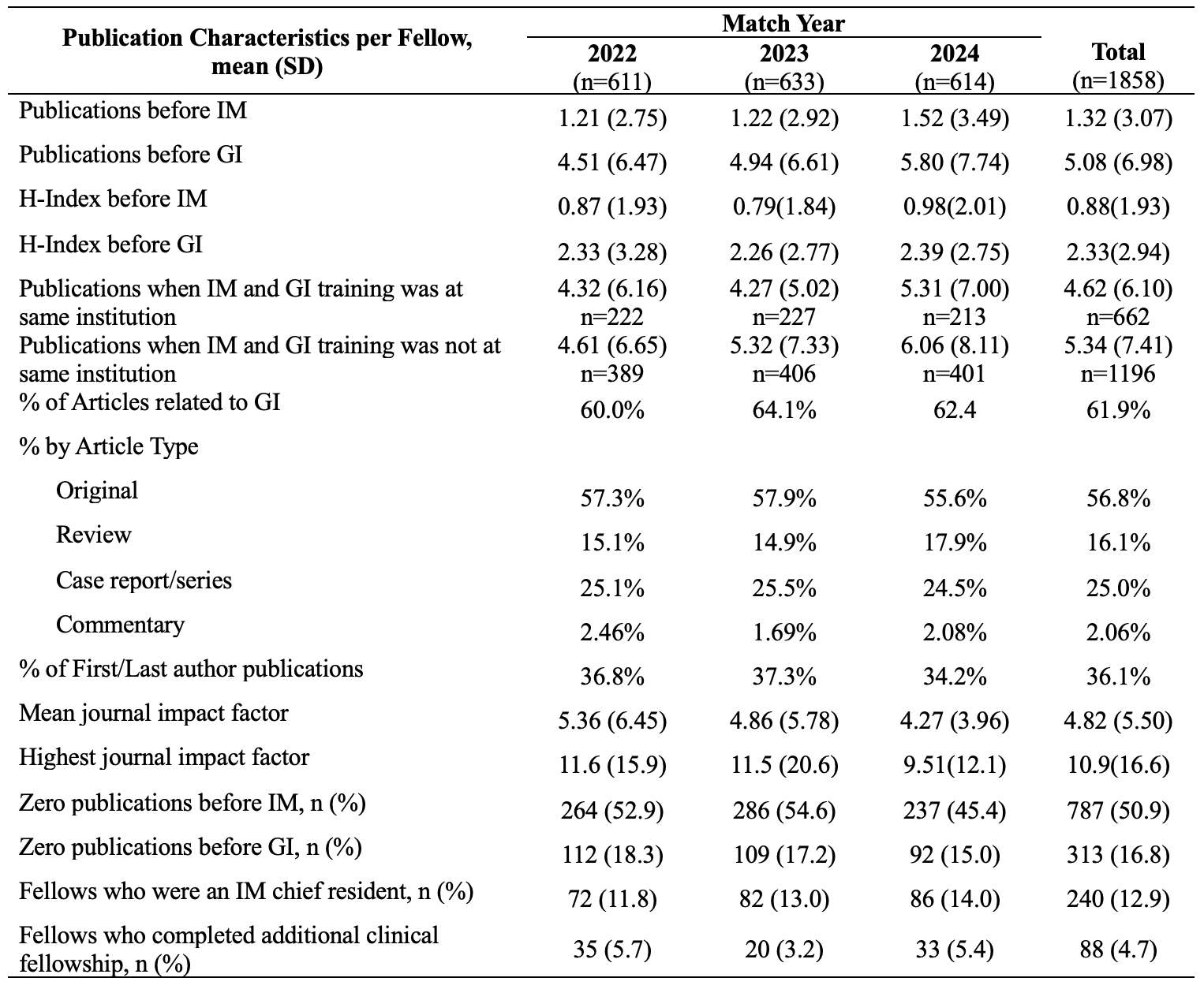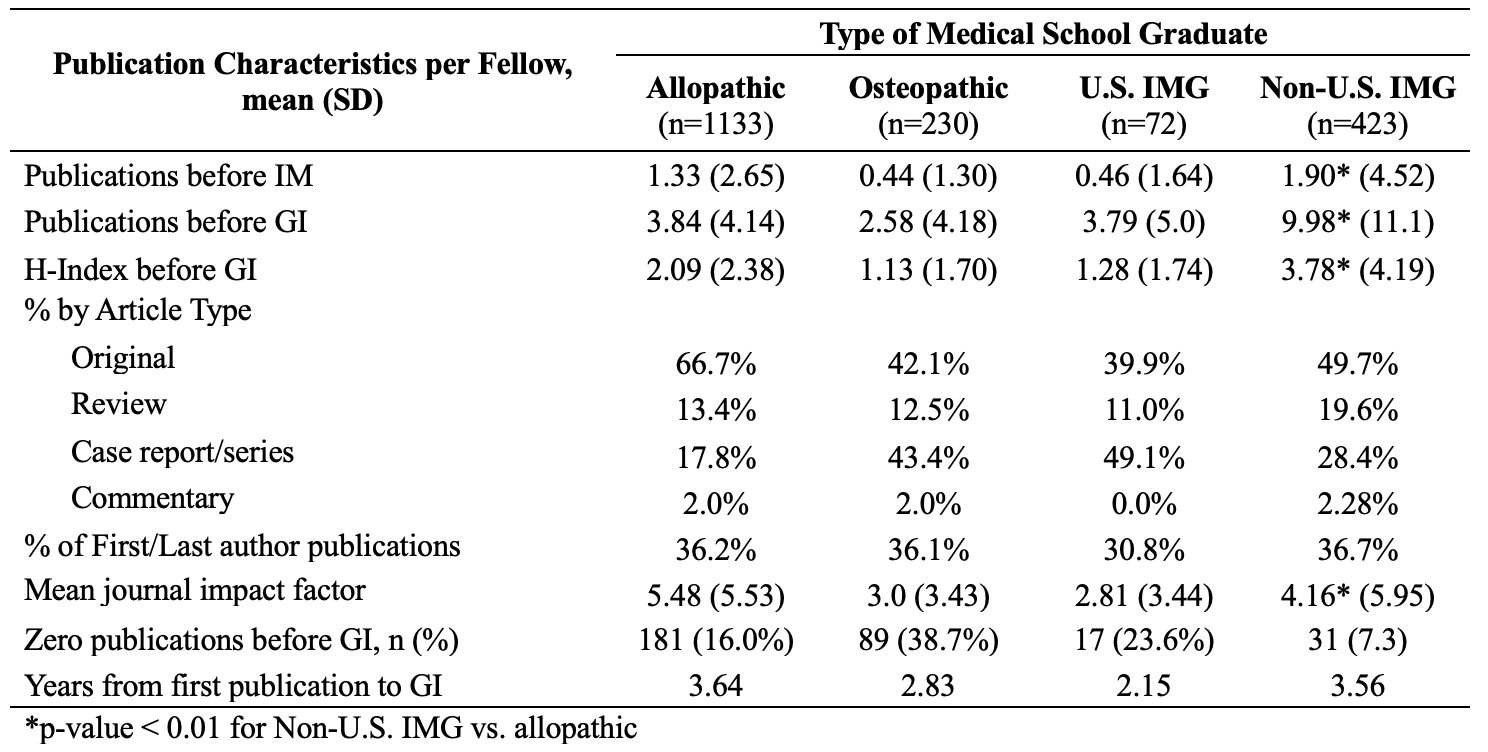Tuesday Poster Session
Category: Practice Management
P6186 - From Intern to Fellow: A Bibliometric Analysis of Research Trends Among Matched Gastroenterology Fellows
Tuesday, October 28, 2025
10:30 AM - 4:00 PM PDT
Location: Exhibit Hall

Cooper A. Bullough, BS
East Tennessee State University Quillen College of Medicine
Johnson City, TN
Presenting Author(s)
Henrik Hahamyan, BS1, Cooper Bullough, BS1, Brice Walkowski, BS1, Landon Brown, BS1, Ahmed Hmidat, MD2
1East Tennessee State University Quillen College of Medicine, Johnson City, TN; 2East Tennessee State University / GI Associates of Northeast Tennessee, Johnson City, TN
Introduction: Research is an important factor in matching into gastroenterology (GI) fellowship, yet limited data exists on the publication output of incoming fellows. It is also unclear whether most research is performed before residency or fellowship. The purpose of this study was to investigate the quantity and quality of peer-reviewed publications of matched GI fellows by start of internal medicine (IM) residency and GI fellowship to elucidate match trends and better inform applicants, advisors, and program directors.
Methods: A bibliometric analysis was performed on fellows that matched into US GI programs in 2022-2024 entering classes. Programs were identified via the ERAS directory, and fellows were identified using program websites and social media. Utilizing PubMed, Google Scholar, and ResearchGate, peer-reviewed publications were identified for each matriculant both before IM residency and GI fellowship (before December 31st of starting the program). Publication metrics were extracted then analyzed using indicated statistics.
Results: Of 228 active GI fellowship programs, 192 had identifiable fellows, totaling 1858 fellows. Fellows averaged 1.32 publications before IM residency and 5.08 by GI fellowship. At IM application, 50.9% had no publications, compared to 16.8% at GI application. By fellowship, 36.1% of publications were first-authored, mean H-index was 2.33, 61.9% were GI-related, and mean journal impact factor was 4.82. Non-US IMGs had significantly more publications and higher H-indexes but published in lower-impact journals than allopathic graduates. Publications before GI fellowship increased significantly over time (p< 0.005), while pre-IM publications did not (p=0.077). GI fellows who stayed at their residency institution had fewer publications at the time of application than those who matched elsewhere (4.62 vs. 5.34, p< 0.05).
Discussion: Our findings suggest that research productivity increases between IM and GI applications with a decreasing rate of those with zero publications, while providing background on current trends in other quality metrics in the match. Publications significantly increased over time aligning with broader match trends. Those who matched at their home institutions had fewer publications than those who did not, suggesting that institutional familiarity may play a role. These findings can help applicants, advisors, and program directors set realistic expectations and goals regarding research during the GI fellowship match process.

Figure: Table 1. Peer-reviewed publication quantity and quality metrics

Figure: Table 2. Peer-reviewed publication quantity and quality metrics by medical school degree
Disclosures:
Henrik Hahamyan indicated no relevant financial relationships.
Cooper Bullough indicated no relevant financial relationships.
Brice Walkowski indicated no relevant financial relationships.
Landon Brown indicated no relevant financial relationships.
Ahmed Hmidat indicated no relevant financial relationships.
Henrik Hahamyan, BS1, Cooper Bullough, BS1, Brice Walkowski, BS1, Landon Brown, BS1, Ahmed Hmidat, MD2. P6186 - From Intern to Fellow: A Bibliometric Analysis of Research Trends Among Matched Gastroenterology Fellows, ACG 2025 Annual Scientific Meeting Abstracts. Phoenix, AZ: American College of Gastroenterology.
1East Tennessee State University Quillen College of Medicine, Johnson City, TN; 2East Tennessee State University / GI Associates of Northeast Tennessee, Johnson City, TN
Introduction: Research is an important factor in matching into gastroenterology (GI) fellowship, yet limited data exists on the publication output of incoming fellows. It is also unclear whether most research is performed before residency or fellowship. The purpose of this study was to investigate the quantity and quality of peer-reviewed publications of matched GI fellows by start of internal medicine (IM) residency and GI fellowship to elucidate match trends and better inform applicants, advisors, and program directors.
Methods: A bibliometric analysis was performed on fellows that matched into US GI programs in 2022-2024 entering classes. Programs were identified via the ERAS directory, and fellows were identified using program websites and social media. Utilizing PubMed, Google Scholar, and ResearchGate, peer-reviewed publications were identified for each matriculant both before IM residency and GI fellowship (before December 31st of starting the program). Publication metrics were extracted then analyzed using indicated statistics.
Results: Of 228 active GI fellowship programs, 192 had identifiable fellows, totaling 1858 fellows. Fellows averaged 1.32 publications before IM residency and 5.08 by GI fellowship. At IM application, 50.9% had no publications, compared to 16.8% at GI application. By fellowship, 36.1% of publications were first-authored, mean H-index was 2.33, 61.9% were GI-related, and mean journal impact factor was 4.82. Non-US IMGs had significantly more publications and higher H-indexes but published in lower-impact journals than allopathic graduates. Publications before GI fellowship increased significantly over time (p< 0.005), while pre-IM publications did not (p=0.077). GI fellows who stayed at their residency institution had fewer publications at the time of application than those who matched elsewhere (4.62 vs. 5.34, p< 0.05).
Discussion: Our findings suggest that research productivity increases between IM and GI applications with a decreasing rate of those with zero publications, while providing background on current trends in other quality metrics in the match. Publications significantly increased over time aligning with broader match trends. Those who matched at their home institutions had fewer publications than those who did not, suggesting that institutional familiarity may play a role. These findings can help applicants, advisors, and program directors set realistic expectations and goals regarding research during the GI fellowship match process.

Figure: Table 1. Peer-reviewed publication quantity and quality metrics

Figure: Table 2. Peer-reviewed publication quantity and quality metrics by medical school degree
Disclosures:
Henrik Hahamyan indicated no relevant financial relationships.
Cooper Bullough indicated no relevant financial relationships.
Brice Walkowski indicated no relevant financial relationships.
Landon Brown indicated no relevant financial relationships.
Ahmed Hmidat indicated no relevant financial relationships.
Henrik Hahamyan, BS1, Cooper Bullough, BS1, Brice Walkowski, BS1, Landon Brown, BS1, Ahmed Hmidat, MD2. P6186 - From Intern to Fellow: A Bibliometric Analysis of Research Trends Among Matched Gastroenterology Fellows, ACG 2025 Annual Scientific Meeting Abstracts. Phoenix, AZ: American College of Gastroenterology.
